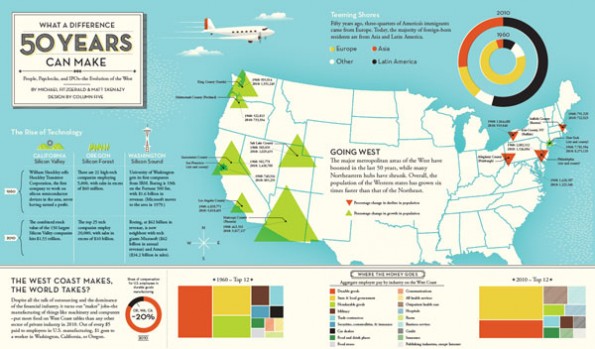The U.S. West Coast: what’s not to love? It smells like citrus (at least near our office) and everybody wears sandals — even our CEOs. In the current issue of Pacific Standard, we took aim at the West—the people and their paychecks—to quantify a few ways in which it defined the latter half of the “American Century”.
Click the graphic below for a breakdown of the ways the West won the last 50 years. For example: In population, growth in California, Washington, and Oregon has been more explosive than in major East Coast cities in recent decades; in terms of aggregate compensation of employees, manufacturing workers on the West Coast took in nearly 20 percent of all US compensation for that industry, which overall paid out more to employees in every other industry all the way until our most recent recession; not to mention all the silicon out here, from California’s Valley to Washington’s Puget Sound.
CLICK IMAGE FOR PDF
(Designed by Column Five)

From the cutting room floor, some other ways the West Coast surprised us:
• Working for a living is out of vogue. In 1960, people in California, Washington, and Oregon, and nationwide, received most of their income from their jobs. By 2010, government benefits (retirement and unemployment benefits, food stamps, etc.) and investment income (dividends, interest, and rent) had dramatically increased the contributions to western wallets. In 1960, government benefits were 6 percent of total personal income for Washington, Oregon, and California. Investment income was 14 percent of personal income (paychecks were 80 percent of income). By 2010, government benefits had risen to 18 percent, investments 17 percent, and the old-fashioned paycheck was limping along at 64 percent. These numbers track a similar change nationwide.
• In the last 20 years, California and, more surprisingly, the State of Washington passed New York as home to the most publishing houses — when you look at the total compensation of employees.
• In 1956, the bulk of foreign goods were exchanged in the U.S. through the ports of New York, New Orleans, Baltimore, Hampton Roads (Va.), and Philadelphia (according to the U.S. Corps of Engineers Waterborne Commerce of the U.S.). But in 2010 the Los Angeles/Long Beach area shipped more than double the value of its nearest competitor — New York — to and from other countries.


